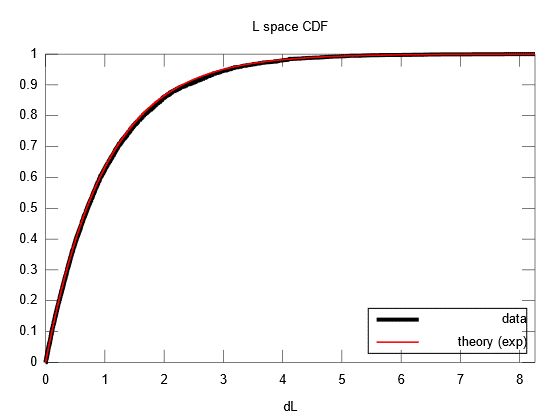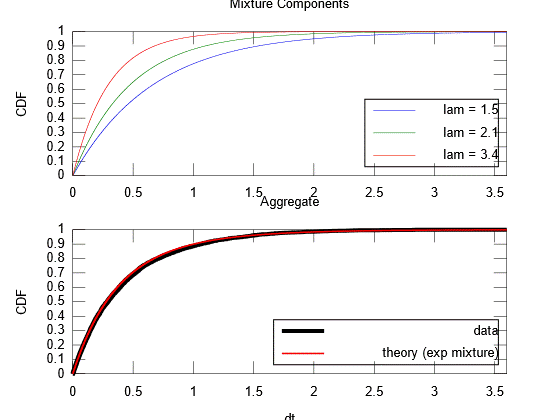There are already several reasonable answers, but to try and add some clarity, here I will try to synthesize these.
Homogeneous Process
For a homogeneous 1D Poisson process with constant rate $\lambda$, the number of events $n$ in a time interval $T$ will follow a Poisson distribution $$n\sim\text{Poiss}_\lambda$$ And the arrival times $t_1,\ldots,t_n$ will be i.i.d. uniformly through the interval $$t_i\sim\text{Unif}_{[0,T]}$$ while the waiting times between events will be i.i.d. exponentially $$\tau_i=t_{i+1}-t_i\sim\text{Exp}_\lambda$$ with CDF $$\Pr\big[\tau<\Delta{t}\big]=1-\exp^{-\lambda\Delta{t}}$$ So a homogeneous Poisson process can be easily simulated by first sampling $n$ and then sampling $t_{1:n}$ (or, alternatively sampling $\tau$ until $t=\sum\tau>T$).
Inhomogeneous Process
For an inhomogeneous Poisson process with rate parameter $\lambda(t)$ the above can be generalized by working in the transformed domain $$\Lambda(t)=\int_0^t\lambda(s)ds$$ where $$\Lambda(t)$$ is the expected cumulative number of events up to time $t$. (As noted in Aksakal's answer, and the reference cited in jth's answer.)
In the generalized approach we simulate in the $\Lambda$ space, where "time" is dilated so in the deformed timeline the Poisson process is now a homogeneous process with unit rate. After simulating this $\Lambda$ process, we map the samples $\Lambda_{1:n}$ into arrival times $t_{1:n}$ by inverting the (monotonic) $\Lambda(t)$ mapping.
Note that for the piecewise-constant rates $\lambda(t)$ here, the mapping $\Lambda(t)$ is piecewise linear, so very easy to invert.
Example
I made a short code in Octave to demonstrate this (listed at the end of this answer). To try and clear up questions about the validity of the approach for small rates, I simulate an ensemble of concatenated simulations. That is, we have 3 rates $\boldsymbol{\lambda}=[\lambda_1,\lambda_2,\lambda_3]$ each of duration 1 hour. To gather better statistics, I instead simulate a process with $\boldsymbol{\hat{\lambda}}=[\boldsymbol{\lambda},\boldsymbol{\lambda},\ldots,\boldsymbol{\lambda}]$, repeatedly cycling through the $\boldsymbol{\lambda}$ vector to allow larger sample sizes for each of the $\lambda$'s (while preserving their sequence and relative durations).
The first step produces a distribution of waiting times (in $\Lambda$ space) like this
which compares very well to the expected theoretical CDF (i.e. a unit-rate exponential).
The second step produces the final ($t$ space) arrival times. The empirical distribution of waiting times matches well with theory here as well:
This figure is a little bit more busy, but can be interpreted as follows. First, the upper panel shows the component CDFs associated with a homogeneous Poisson process at each of the three $\lambda$'s. We expect the aggregate CDF to be a mixture of these components $$\Pr\big[\tau<\Delta{t}\big]=\sum_iw_i\Pr\big[\tau<\Delta{t}\mid\lambda=\lambda_i\big]$$ where $w_i=\Pr\big[\lambda=\lambda_i\big]$ are the mixing fractions.
For each component process, the expected number of samples is $\langle{n_i}\rangle=\lambda_iT_i$. Since the durations $T_i$ are equal, the expected mixing weights will then scale with the rates, i.e. $$w_i\propto\lambda_i$$ The lower panel above shows the expected CDF obtained by mixing the components in proportion to their rates. As can be seen, the empirical CDF of the inhomogeneous simulation is consistent with this theoretically expected CDF.


